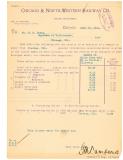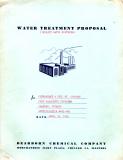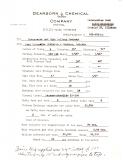
| Home | Open Account | Help | 366 users online |
|
Member Login
Discussion
Media SharingHostingLibrarySite Info |
Steam & Excursion > Water testing circa 1942Date: 09/13/17 15:47 Water testing circa 1942 Author: metra6924 There have been several interesting discussions regarding water quality, testing and treatment. My dad recently gave me a stack of old papers to look at, including this report from the C&NW regarding a well in the Chicago area. I thought some of you might find it interesting.
  Date: 09/13/17 15:49 Re: Water testing circa 1942 Author: metra6924 Date: 09/13/17 17:09 Re: Water testing circa 1942 Author: callum_out I find the 1270 foot well depth interesting considering the proximity to a large body of water.
Out Date: 09/13/17 19:17 Re: Water testing circa 1942 Author: -AWF- Your post reminded me of the "misc." folder of Pere Marquette and Chesapeake & Ohio documents I have. Attached are two scans of a proposal (it was eventually approved and installed) from the Dearborn Chemical Company and the Pere Marquette Division of the Chesapeake & Ohio. Its surprising that the railroad was investing in steam locomotive maintenance so late in the game.
  Date: 09/13/17 19:36 Re: Water testing circa 1942 Author: jcaestecker Water quality, as regarding alkali content, to boilers is similar to water quality, as regarding alkali content, to the manufacturing of paper. Too much is no bueno.
-John Date: 09/14/17 06:32 Re: Water testing circa 1942 Author: sgriggs The railroads devoted significant resources to water treatment for steam locomotives. Large railroads had considerable physical infrastructure for water treatment and chemists on the payroll to monitor and maintain proper water quality. This was one more factor working against steam locomotion when the diesel electric came along...
Date: 09/14/17 09:53 Re: Water testing circa 1942 Author: march_hare callum_out Wrote:
------------------------------------------------------- > I find the 1270 foot well depth interesting > considering the proximity to a large body of > water. > > Out Probably an attempt to get around having to pay for city water. But 1270 feet is a long way to go for water in that area. Despite the Potsdam Sandstone being a pretty good aquifer, it's to be expected that dissolved solids will go up with depth. Date: 09/14/17 14:55 Re: Water testing circa 1942 Author: kevink march_hare Wrote:
------------------------------------------------------- > Probably an attempt to get around having to pay > for city water. But 1270 feet is a long way to go > for water in that area. Despite the Potsdam > Sandstone being a pretty good aquifer, it's to be > expected that dissolved solids will go up with > depth. Without having to dig through the Illinois Water Survey site, that depth seems in line with what I recall many municipalities in the western Chicago suburbs were dealing with before most of them switched to Lake Michigan water. Before the switch, many residents used water softeners to get as much iron and minerals out of the water as they could. My folks had theirs removed within a year after getting lake water and I removed the one in the house I bought in 1997. Date: 09/14/17 16:13 Re: Water testing circa 1942 Author: HotWater kevink Wrote:
------------------------------------------------------- > march_hare Wrote: > -------------------------------------------------- > ----- > > Probably an attempt to get around having to pay > > for city water. But 1270 feet is a long way to > go > > for water in that area. Despite the Potsdam > > Sandstone being a pretty good aquifer, it's to > be > > expected that dissolved solids will go up with > > depth. > > Without having to dig through the Illinois Water > Survey site, that depth seems in line with what I > recall many municipalities in the western Chicago > suburbs were dealing with before most of them > switched to Lake Michigan water. Before the > switch, many residents used water softeners to get > as much iron and minerals out of the water as they > could. My folks had theirs removed within a year > after getting lake water and I removed the one in > the house I bought in 1997. Interesting, and glad you brought that up. We live in Western Springs, and our village STILL has an elaborate well system for our water supply. We never have water restrictions, no mater how serious the drought. They are now exploring the cost of drilling a fifth well! Date: 09/14/17 21:15 Re: Water testing circa 1942 Author: filmteknik I'm down in Park Forest and we have a network of wells feeding our water plant which includes a softener of some sort. Most of the surrounding towns use Lake Michigan water from Chicago by way of Oak Lawn.
Back to trains. With all the expense to provide water, treat it, the waste of having to stop and take on water, the waste of having to blow down the boiler, as I've said before, I'm surprised more effort was not put into condensing locomotives. No more water stops. No more chemicals (beyond some initial treatment). No more blowdowns. Clean water recycled over and over so the boiler stays clean. |